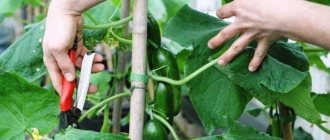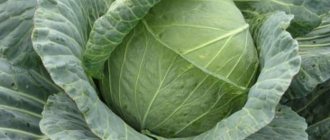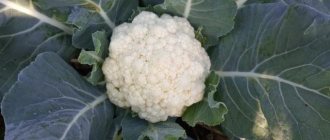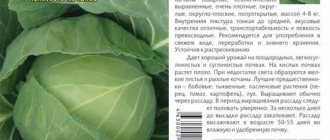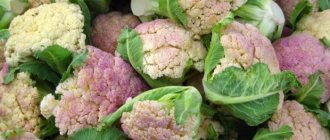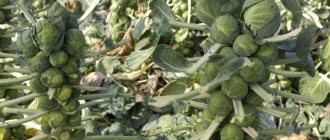Many gardeners wonder if removing the bottom leaves is beneficial for getting a better cabbage harvest? To answer this question, it is worth understanding the main reasons why removal is usually performed and the correct order of the procedure. You can find out about this by reading this article.
Why is it deleted?
Below is a list of reasons why cabbage leaves are usually removed. It is revealed when removal is reasonable and when it is possible to do without it.
Prevention and treatment of diseases
The process of plant death due to vascular bacteriosis begins with the lower leaves. Some gardeners mistakenly believe that after cutting off the bottom of the cabbage, the disease will subside. But that's not true. Moreover, the disease can spread to nearby heads of cabbage. Therefore, the diseased plant must be destroyed.
Removing leaves as a preventive measure can make healthy cabbage heads more vulnerable.
Pest breeding prevention
A parasite such as cabbage fly or cutworm attaches its eggs to the outside of leaves. When a pest is detected, it is really better to tear off and destroy the affected parts of the plant. But this measure will not be enough; you should additionally spray the plants with pest control agents. Agrofit is perfect.
It is not worth getting rid of the leaves in advance, since then the pest can lay eggs on another part of the head of cabbage.
In a similar way, cabbage heads are protected from aphid invasion.
Extending the ripening period of early varieties
Inexperienced gardeners try to slow down the ripening of early varieties by tearing off the lower leaves. But this method is incorrect, because cabbage stops growing, loses nutrients and becomes more vulnerable to diseases and pests.
It's better to just take a head of cabbage, pull it towards you, then turn it clockwise. This way it will stop receiving moisture, but will retain its qualities in the garden for a long time.
You should pull carefully so as not to pull the roots out of the ground.
Prevention of rotting
If the soil around the head of cabbage is excessively moistened, the lower leaves may begin to rot. To prevent the rotting process from spreading to the entire head of cabbage, it is correct to remove the lower leaves.
Prevention of cracking
To prevent the head of cabbage from becoming overripe and cracking, you can cut off the lower leaves as soon as it reaches optimal maturity. But this will only help slow down the process for a short period of time.
With a loose structure of the head of cabbage
The head of cabbage becomes loose if the plant lacks nutrients, and it continues to accumulate them in the lower leaves. Tearing, in this case, can help the correct distribution of substances. But timely application of fertilizers will be more useful.
For weight gain
Another partially erroneous opinion is that removing the lower leaves can increase the size of the head of cabbage. On the contrary, if you remove the head of cabbage along with the lower leaves shortly before full ripening, then it will continue to grow and develop due to the accumulated substances even after being collected from the garden. You can expect a weight gain of up to 15%. The rule only works when the head of cabbage reaches full maturity.
In some species, the lower leaves consume accumulated substances, thereby depleting reserves. The structure of the head of cabbage becomes less dense, and the leaves are not as crispy.
You can find out whether it is worth removing the lower leaves of cabbage in order to increase the weight of the head of cabbage by watching the presented video:
With a tight fit
If cabbages are planted too close together, the growth of lower leaves may interfere with the normal growth and maintenance of neighboring plants. In this case, the largest bottom sheets can be removed.
The period of formation of cabbage heads
Under suitable conditions, seeds germinate within 3-4 days. Leaves begin to form at least a week after the appearance of cotyledons, which form on the 5th day of germination.
Young cabbage is preparing to release a rosette
The leaves grow one at a time, while the seedlings form 5-7 leaves, each forming within 6-8 days.
As cabbage develops, it gains growth intensity, the maximum of which provides the bush with 5 leaves within 5 days.
For reference! The rosette of cabbage varieties of vegetables has from 25 to 44 leaves; along with the appearance of new shoots, old ones continue to grow.
The head of cabbage emerges from the apical bud due to a decrease in the rate at which new leaves emerge from it. They are responsible for increasing the size of the plant's head, whose lower leaves die off over time.
Such varieties of cabbage as, for example, Peking cabbage are early ripening. And for a mid- and late-ripening white cabbage variety, the formation of a head of cabbage will require about one and a half hundred days. Tying the head into more or less of them is due to the specifics of the growing conditions.
Deletion rules
There are 2 basic rules:
- Gradualism. You should not remove all the leaves at once, as this may have a negative effect on the plant.
It is better to remove 1 leaf per week when the cut area dries out. You can delete not the entire sheet, but, for example, half. This is done if they interfere with plant care. - Accuracy. It is not recommended to tear off the leaves; they must be cut off carefully so as not to harm the plant. The cut area should be thoroughly disinfected and then treated with wood ash. This will protect you from contracting diseases.
If leaves are removed incorrectly, pests can be attracted.
Care after removing the lower leaves
After pruning, it is not recommended to water the cabbage beds for the first 2-3 days. Due to moisture, active sap flow begins, which negatively affects the speed of drying of the cuts.
To improve the taste of cabbage and increase its shelf life, phosphorus-potassium fertilizers are applied in September. For 10 liters of water dilute 2 tbsp. l. facilities. As a result, the leaves will become denser, which will save the heads of cabbage from rotting.
In warm autumn, aphids are still active. It is important to constantly monitor its appearance. To get rid of this pest, use a soap solution: dilute 40 g of soap per 1 liter of water. After processing, everything is sprinkled with ash.
In autumn, slugs cause the most damage. Slaked lime is used against them: 50 g of powder is scattered per 1 m².
This is interesting:
Why cabbage leaves turn yellow and what to do about it
Why did cabbage leaves turn purple and what to do about it?
Let's find out whether there is starch in cabbage and what are the benefits and harms of starchy vegetables
Should I remove leaves from cauliflower and Chinese cabbage?
A common misconception is that trimming the lower leaves will produce better cauliflower forks. But without them, the growth of the vegetable slows down, since there is a lack of nutrients, which are abundant in the lower part. Removing the leaves can also be done to protect the cabbage head from the bright sun during the setting period. An alternative to this would be to use rhubarb or burdock leaves.
Chinese cabbage has outer leaves that are as tender as the entire head. Due to the nutrients accumulated in them, the plant grows and develops. It is important to remove them only if they begin to wither or rot. But this rarely happens. Typically, Chinese cabbage heads grow well without extreme measures and produce several harvests per season.
Technique for cutting cabbage rosettes
For beginning gardeners, it is suggested that they follow this algorithm of actions when removing cabbage tops.
- Select the bottom pair of leaves that you plan to delete.
- Remove the leaves, breaking them off as close to the stump as possible.
- Sprinkle the wound remaining on the stem with wood ash, activated carbon or tobacco dust.
After removing the leaves, it is not recommended to water the cabbage for a couple of days. Watering will provoke active sap flow in the plant, which will slow down the drying of the wound.
Advantages and disadvantages of the procedure
To summarize, there are several positive points:
- Protection. The procedure allows you to protect the crop when damaged by harmful insects.
- Life extension. Once the lower leaves begin to rot and wilt, cutting them off helps extend the shelf life of the vegetable. In addition, the vegetable acquires a marketable appearance.
- Seal. After removing the leaves, the heads of cabbage become tighter. But in this case, the procedure must be carried out 2-4 weeks before harvest, depending on the cabbage variety.
But you should also pay attention to the disadvantages of the procedure:
- Loss of thermoregulation. Thanks to the lower leaves, temperature and optimal humidity levels are controlled. Their loss makes the cabbage more susceptible to the influence of negative factors.
- Vulnerability to external influences. The upper leaves protect the head of cabbage from the sun and pollution.
- Violation of natural development. Normally, the lower leaves are needed for the head to ripen. If this process is disrupted, improper distribution of nutrients or their complete loss may occur. The plant dies or does not reach its optimal size.
Is it worth removing the bottom leaves of cabbage? You can watch the video about their role in the formation of the head of cabbage, the effect on keeping quality and the preservation of nutrients:
When is the procedure performed?
The procedure is carried out the day before harvest. The timing depends on the variety. Early cabbage is harvested from late June to mid-July, middle cabbage - from the second half of August to early September, and late cabbage - from late September until the onset of frost, when the temperature drops to -5°C.
If you decide to try this method in practice, you need to take into account several key features. Namely:
- Only yellowed and wilted leaves can be removed. They have already given all the useful elements to the head of cabbage and do not take part in photosynthesis. That is, they do not convert light energy into chemical compounds and cannot provide nutrition to the fetus.
Withered leaves must be removed without a doubt: they will no longer bring any benefit to the plant, and they may well infect the fruit with an infection.
- Yellow and blackened leaves that are affected by diseases are also removed. The development of infection leads to such consequences.
- If the leaf begins to turn yellow, the veins turn black, and a network forms on the plate, the plant is affected by vascular bacteriosis. In this case, removal is necessary. If the leaves are not removed, the infection will penetrate into the stalk and then into the fruit.
- There is another disease for which such a procedure is necessary. This is downy mildew, which can be recognized by yellowed leaves and the appearance of a white coating on their lower part. Removal prevents the spread of infection.
It is important to stop the development of diseases (for example, peronosporosis) in time - otherwise it will lead to dire consequences
- Decaying leaves, which can infect other leaves and the head of cabbage, are also removed.
Important! Excessive watering and heavy rainfall lead to rotting of the plates.
Reviews from experienced gardeners
★★★★★
Ivan, 55 years old. Last year I discovered signs of vascular bacteriosis on cabbage leaves.
On the advice of a neighbor, I tore off the bottom leaves. But after a while I noticed that the disease was progressing and even began to spread to neighboring heads of cabbage. I almost lost my entire harvest. I don't do that anymore. ★★★★★
Anna, 47 years old. In our region it is usually rainy, and by the end of the season the lower leaves begin to rot.
You have to tear them off to protect the head of cabbage. For me this method is effective. ★★★★★
Sergey, 61 years old. Previously, I cut off the lower leaves to protect the heads of cabbage from cracking.
But last year I didn’t do this, which had almost no effect on the culture. Now I tear off the leaves only if the cabbage grows too much and this interferes with caring for it. Hide
Add your review
Gardeners have mixed opinions about cutting off the lower leaves. Some say that this helps protect the culture, while others, on the contrary, believe that this makes the cabbages more vulnerable. We can definitely say that you should not remove the lower leaves if the plant develops normally and is not damaged by pests.
0
0
Copy link
What types of cabbage do not need to remove leaves?
Other types of cabbage - broccoli, kohlrabi, cauliflower - do not need pruning. For colored varieties, this procedure is generally contraindicated - the thick “plumage” helps the fork to tie and not darken. An exception is Brussels sprouts, which forms many small heads of cabbage on the stem.
Brussels sprouts are a rare guest in our gardens. Many summer residents refuse to grow this valuable vegetable only because they do not know the main feature.
In order for the Brussels sprout to set numerous heads, in the second half of summer it is necessary to pinch the top and trim the rosette.
Then the plant will move from the vegetative type of development to the generative one, and the future harvest will get more sun and nutrients. This feature is associated with the long growing season of Brussels sprouts – over 6 months. In warmer countries it grows without additional manipulation.
Pruning tops of cruciferous crops should not be done thoughtlessly. It can be beneficial, but in most cases it is harmful. Still don't believe me? Carry out a simple experiment, and in a year you will no longer doubt whether you need to pick off the leaves of cabbage.
The appearance of insect pests on the lower leaves of cabbage
Many insect pests of cabbage overwinter in the ground. In spring they emerge from the soil and immediately move to the lower leaves. If you find insect larvae or eggs in the lower part of the plant, immediately tear off these leaves. This way you can save your crop from cabbage flies, moths or whites. However, often this measure is not enough, because The pests have already spread throughout the garden bed. In this case, you will have to treat the plantings with suitable insecticides, for example Fitoverm.
- Fitoverm - instructions for use, action of the insecticide. Safety measures for Fitoverm, compatibility.
Cracking of heads of cabbage
Often, early varieties of cabbage that are not removed from the garden in time begin to crack. Some summer residents, trying to artificially delay their ripening, tear off the lower leaves. The plant temporarily stops the formation of heads of cabbage and directs all its efforts to restoring the lost green mass: new leaves begin to grow in place of the cut ones.
However, there is a more effective way to somewhat slow down the ripening of the cabbage crop. Lightly pull the head of cabbage out of the ground and twist it in any direction. After this, the plant’s nutrition, and therefore its growth, will be disrupted, but the cabbage, while in the soil, will retain its qualities for some time. However, during this procedure, be very careful not to accidentally pull the head of cabbage out of the ground completely.
- Why cabbage cracks and how to avoid it
Cracks in cabbage may appear if the care regime is not correct. We'll tell you what you're doing wrong and how to fix it.
When to prune
The loss of lower leaves is always stressful for cabbage, but in some situations the pruning procedure can be considered advisable.
Removal may be necessary:
- If the lower part of the cabbage bush begins to rot. The plant must be freed from dying organs that will no longer be able to provide it with nutrition, while in their decomposing tissues a favorable environment is created for the development of pathogenic microflora.
- If the leaves prevent the flow of water to the roots when watering, they interfere with the hilling procedure, which is important in cabbage farming.
Drying or dry leaves can be removed entirely, since the plant has already selected useful substances from them. But the yellow ones, which have not yet dried out, continue to provide the head of cabbage with nutrition from the petioles; if necessary, it is recommended to partially cut off such leaves.
- When the cabbage head has formed and began to ripen, the old leaves lying on the ground should be cut off as a preventive measure for fungal diseases. With the arrival of autumn rains, they are highly likely to begin to rot.
- If a plant is infested with aphids, removing the lower leaves on which the insect resides can be an alternative to harmful chemical treatments. It is worth resorting to this method in extreme cases, when folk remedies and mechanical removal methods do not help, and pest damage threatens the harvest. The cut material must be burned.
It is not recommended to trim:
- Before tying, fork the cabbage. To form a head of cabbage, you need at least seven leaves in a rosette. In addition, pruning at the initial stage of development will delay the formation of the ovary, since the plant will spend part of its energy on healing the “cuts”. As a result, by the time of harvesting from the garden, the cabbage “head” will grow smaller than it could.
- Healthy green and even yellow leaves. Heads of cabbage continue to intensively select nutritional elements from them, due to which their weight rapidly increases at the last stage of development. It is especially important to preserve the lower tier of cabbage varieties of medium and late ripening.
- Do not remove strong green leaves from heads of cabbage even after harvesting. Even cut cabbage forks continue to consume nutrition from them, due to which the weight of the cabbage head removed from the stem can still grow up to 15% of the total weight.
Controversial reasons for pruning are the following situations:
An effective prevention of looseness will be reasonable moderation in nitrogen fertilizing.
Why can't you pick it?
The lower part is considered the assimilating apparatus of cabbage; the harvest depends on it, and nutrients enter the head from here. The process of plant development is accompanied by an increase in the concentration of nutrients in the inner and outer leaves. The main argument against removing cabbage leaves is considered to be a reduction in the amount of nutrients. Lower vegetation contains large amounts of vitamin C, and their removal leads to its loss.
A layer of wax located on the leaves protects the plant from damage, diseases, and insects. It is also believed that the removal of lower vegetation can lead to the death of the root system, this phenomenon is observed every time.
In accordance with agrotechnical rules, it is also not recommended to get rid of the lower leaves of adult cabbage. There is a danger that harmful bacteria penetrate the vegetable through open wounds, which leads to the development of various diseases.
It is worth noting that cutting off the leaves also leads to the redirection of nutrients to the upper leaves, as a result of which the growth of the head of cabbage practically stops. There are no specific recommendations on the advisability of carrying out this procedure in specialized gardening manuals.
Why pick off the lower cabbage leaves?
Picking off near-earth tops from heads of cabbage is allowed only in cases where the benefit from this outweighs the possible harm.
- The planting is too thick, poorly ventilated, and there is a risk of forks rotting or being affected by various diseases.
- The soil is not fertile enough, poor in nutrients, the forks are loose. In this case, it is necessary to break off the near-ground part of the rosette so that the head of cabbage ripens and becomes denser.
- When the lower tops turn yellow from lack of moisture, it is better to remove them, since they will no longer be useful.
- If they interfere with the hilling of plants, watering, or the penetration of moisture to the roots, they must also be torn off.
Role and value
The lower or outer leaves are a full-fledged organ of the cabbage bush, performing a number of functions, so their removal can negatively affect the condition of the plant and the volume of the harvest.
- All parts of cabbage are involved in photosynthesis; the loss of any of them disrupts metabolic processes.
- The lower (green) leaves are necessary for cabbage to accumulate nutrients coming from the roots, which are later redirected to the inner (white) leaves, which form the head of cabbage.
- Covering leaves perform the function of thermoregulation; forks deprived of this protection may suffer from both overheating and hypothermia.
- The green “shell” enveloping the cabbage head is covered with a coating that protects against the penetration of pathogenic microorganisms into their tissues and damage by pests.
- In case of drought, the middle and central parts of the cabbage can receive moisture from the peripheral parts for some time. In addition, the lower leaves shade the tree trunk, slowing down the evaporation of water from the soil. Cabbage is a moisture-loving crop, so water shortages quickly affect the development of cabbage fork.
Features of cultivation
The first few weeks it is necessary to carefully care for the young seedlings. Young seedlings are not yet accustomed to the sun's rays, so during the day they need to be covered with newspapers or cloth. Further care for cabbage is as follows:
- Watering. It is recommended to water the plant on cloudy days or in the evening so as not to harm the bushes. It is enough to do this once a week. In summer, the amount of watering can be increased several times so that the cabbage has enough moisture. To keep water in the soil longer, it is recommended to create a peat mulch layer.
- Feeding. The first feeding is carried out 10-15 days after planting the seedlings in the soil. During this period, a mixture prepared from nitrate, potassium, superphosphate and water is added to the ground. Fertilizers should be applied only to moist soil so as not to accidentally damage the plant. The second is applied a few weeks later and consists of the same fertilizers as the previous one.
- Treatment. To protect the bushes from diseases and insects, it is recommended to treat them. First, the cabbage is treated with ash, which can protect young seedlings from fleas and slugs. Then you can use an infusion of tomato tops or onion peels. There are also special preparations that can be used to protect cabbage from most diseases.
See also
What to do if cabbage stands still and does not grow, what to feed itRead
The importance of pruning tomato foliage
At the very beginning of the ripening of tomato fruits, many gardeners think: is it necessary to pick off the leaves of tomatoes? Removal using garden shears or tearing off by hand is a necessary procedure that is carried out both at the initial stage of trunk formation and throughout the season.
Some varieties do not require cutting off the greenery at all, for example, ultra or early ripening varieties. They do not need to form a bush, but other varieties are very demanding in terms of trunk formation.
What this process gives to tomato plantings:
- Improves ventilation and oxygen absorption;
- Maximum enrichment with fertilizer occurs during spraying;
- Plants receive more light to produce chlorophyll;
- There is a better supply of useful elements to the fruits;
- The greenhouse maintains the required temperature and humidity;
- The fruits ripen better both in the garden and under the film.
Which leaves are cut off first? When did the first flowering brush appear? During the flowering period, it needs nutrients, and the lower leaves take everything for themselves. The cutting pattern is visible in the picture.
Further manipulation should be carried out when the tomatoes begin to ripen on the first bunch. It is recommended to remove the lower leaves. Why is this being done? If they are not removed, they will also take away the nutrients so necessary for the fruit during the ripening period.
Pruning is carried out in the first half of the day so that the cut has time to dry by night and does not rot. In one procedure, you can remove only 2-3 leaves so as not to cause severe stress to the plant.
